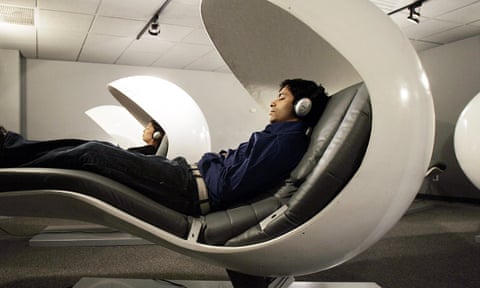One of the more annoying habits of highly successful people is their tendency to advertise how little sleep they need. Former Yahoo boss Marissa Mayer can operate on four hours, Apple CEO Tim Cook is at the gym by 5am and designer and film director Tom Ford gets three hours a night, and keeps Post-it notes by his bed in case he wakes up with an idea.
Stealing an extra 20 minutes in bed in the morning is practically taboo in the world of high-stakes business, where snoozing has long been equated with losing.
Arianna Huffington has been on a mission to destigmatise sleep after collapsing from exhaustion 10 years ago.
Describing the incident as a “wake-up call”, the Huffington Post founder wrote a book called The Sleep Revolution and launched Thrive Global, which provides workplace wellness training for corporations. “That idea that sleep is somehow a sign of weakness and that burnout and sleep deprivation are macho signs of strength is particularly destructive,” Huffington says. “So changing the way we talk about sleep is an important part of the culture shift.”
But it’s not just those at the top of the corporate ladder who feel under pressure to power through. Most of us are getting less sleep. While sufficient sleep is generally defined as between seven and nine hours, a National Sleep Foundation survey [pdf] found the average adult in the UK is getting just six hours and 49 minutes, in the US that’s six hours and 31 minutes, and Japan is worse again at six hours and 22 minutes.
“There’s a Gallup poll from 1942 that demonstrated that the average adult was sleeping 7.9 hours, so I think there’s been a remarkable lopping off of sleep time,” says Matthew Walker, neuroscientist and author of Why We Sleep: The New Science of Sleep and Dreams.
Walker says we are in the midst of a “global sleep-loss epidemic” and that demanding work schedules and commutes are among the contributing factors. “Longer commute times and longer hours are squeezing sleep almost like vice grips,” he adds.
Sleep loss can seriously damage your health. “There isn’t really any aspect of your health, mind or wellness that isn’t dependent on sufficient sleep,” Walker says. But it’s the impact it has on productivity that is starting to make some companies revise attitudes to sleep and rest. Lack of sleep costs most developed nations 2% of their GDP, which for the UK equates to £40bn.
Employers are starting to recognise the importance of sleep. Google has installed sleep pods in its offices for staff requiring a nap. The high-tech beds, which look like the hibernation chambers in Alien crossed with Pac-Man, include a built-in sound system for those who like to drift off to relaxing music.

Photograph: Alamy
An afternoon nap can help improve performance without interfering with night-time sleep, according to Rita Aouad, psychiatrist and sleep specialist at Ohio State University. “Lots of research shows that a nap of about 20 minutes in the afternoon has a positive effect on attention vigilance mood and alertness,” she says.
Nike’s headquarters in Portland, Oregon has rooms where employees can sleep or meditate. The company is among those offering flexible work times to employees to suit their chronotype – the internal clock that programmes your ideal sleep time and dictates whether you are a morning person or a night owl. “Morning types are celebrated and deemed more worthy because they are in the office earlier,” says Walker. “Evening types are usually penalised because they come in late, but they could work late. Companies are starting to understand that it’s nobody’s fault – it’s genetic.”
Procter & Gamble has lighting systems in its offices that regulate melatonin, the sleep hormone, to help employees switch off in the evenings. Ben & Jerry’s was an early adopter of this understanding approach to the need for rest and relaxation, and has had a nap room at its headquarters for over a decade. The company’s HR director Jane Goetschius says that along with other perks, such as yoga classes and an on-site gym, the nap room is part of a wider strategy to show employees they’re appreciated. “We want you to bring your whole self [to work]. It builds more productivity,” she says.
It’s not just the big corporations that are investing in a well-rested workforce. Shai Aharony, founder of London-based online marketing agency Reboot, encourages staff to take a nap in a dedicated quiet room in the office if they’re feeling drowsy, and tries to prevent work emails after hours. “We send an automated response to clients who email after work hours saying the email won’t be dealt with unless it is urgent and re-sent marked urgent,” he says. “The vast majority of the time the client will just leave it because it makes them think. It has made a huge difference.”
But will efforts like these have much of an impact? “I’m broadly in favour of nap pods, even if they just signal some degree of recognition of sleep’s importance in the workplace by people in senior positions,” says Walker.
Organisational, societal and structural change is what’s required, he says, adding that moves like the French government’s decision to impose a law that gives workers the right to disconnect from emails out of hours should be encouraged.
“Sleep has an image problem. In this modern day and age we have not only abandoned a full night’s sleep, we don’t celebrate it anymore,” he says. “We have to return to this mentality that sleep is OK.”
